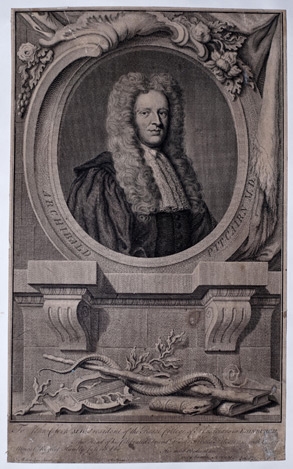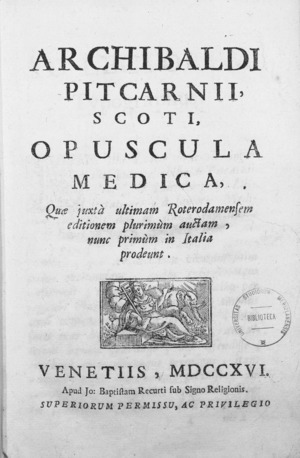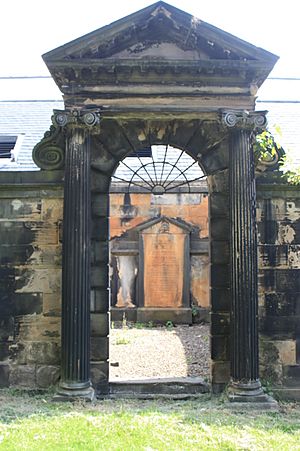Archibald Pitcairne facts for kids
Archibald Pitcairne (born December 25, 1652 – died October 20, 1713) was a famous Scottish physician and poet. He first studied law in Edinburgh and Paris, earning a Master's degree (MA) in 1671. Later, he decided to study medicine and started working as a doctor in Edinburgh around 1681.
In 1692, he became a professor of medicine at Leiden University in the Netherlands. However, he resigned his position and returned to Edinburgh in 1693. Pitcairne was known for his strong opinions and witty jokes, especially about the strict rules of the Presbyterian church. He was also known for writing two satirical works, 'The Assembly, or Scotch Reformation: a Comedy' and 'Habel, a Satirical Poem,' both from 1692. He also wrote many poems in Latin. Archibald Pitcairne was one of the most celebrated doctors of his time.
Contents
Early Life and Education
Archibald Pitcairne was born in Edinburgh, Scotland. He went to school in Dalkeith, where he received a good education in classic subjects. In 1668, he started studying at Edinburgh University and earned his Master's degree (MA) in 1671.
After traveling to France for his health, he became interested in medicine while in Paris. He studied medicine in both Edinburgh and Paris. In 1680, he earned his Doctor of Medicine (MD) degree from Reims University.
Becoming a Doctor and Professor
Pitcairne began his medical practice in Edinburgh. In 1685, he was chosen as one of three professors of medicine at the Royal College of Physicians of Edinburgh. He quickly became very well-known and respected.
Because of his great reputation, he was offered a special job in 1692. He became the Professor of the Practice of Medicine at the University of Leiden in the Netherlands. Many of his students, like Richard Mead and George Cheyne, later became famous doctors themselves. They often said that much of their medical skill came from what they learned from Pitcairne. It is also believed that he taught Herman Boerhaave, a very important Dutch physician, during his time in Leiden.
In 1693, Pitcairne returned to Scotland to marry the daughter of Sir Archibald Stevenson, another important doctor in Edinburgh. Her family did not want her to move abroad, so Pitcairne decided not to go back to Leiden. Instead, he settled permanently in Edinburgh. He became the most important doctor in Scotland and was often asked for advice by doctors in England and the Netherlands.
Studying the Human Body
Soon after returning to Edinburgh, Pitcairne made an offer to the city council. He and his colleagues would treat poor people for free at a hospital called Paul's Work, located near Calton Hill. In return, he asked for permission to study the bodies of those who died at the hospital and whose families did not claim them. These bodies would normally be buried at the city's expense.
Some surgeons in Edinburgh strongly disagreed with this idea. However, the town council eventually accepted Pitcairne's offer. This agreement greatly helped the teaching of medicine at the University of Edinburgh.
Pitcairne's medical ideas are mostly found in his book, Dissertationes medicae, which he published in 1701. He was good friends with the mathematician David Gregory. Together, they wrote mathematical papers. These studies helped Pitcairne believe that Newtonian physics could better explain how the body works than older ideas like the balance of humours.
In his book, Pitcairne discussed many topics. These included how blood moves in tiny vessels, differences in blood in the lungs of unborn animals compared to after birth, and how food turns into blood. He also wrote about treating fevers with certain medicines, the effects of acids and alkalis in medicine, and who truly discovered things in medicine. For example, he strongly supported William Harvey as the discoverer of blood circulation, not Hippocrates. His support for this new 'iatromechanical' theory, which applied physics to medicine, was a big reason for his teaching jobs in Edinburgh and Leiden. He even wrote to Isaac Newton and visited him in 1692.
His Writings
Pitcairne was very good at classical studies and wrote Latin poems. He was also a co-writer of a comedy called The Assembly, or Scotch Reformation. This play was originally named The Phanaticks (1691). He also wrote a satirical poem called Babel. This poem made fun of important Presbyterian religious leaders of his time, whom he disliked because he was a strong supporter of Jacobitism.
Some historians believe that Pitcairne might have worked with David Gregorie and Bertram Stott on The Assembly. This play was meant to be read, not performed on stage, during Pitcairne's life. Its jokes about Presbyterianism were considered too rude for public performance.
His Personality and Friends
Pitcairne was known for his jokes and strong opinions. Because of this, some people thought he was an unbeliever, though he said he believed in a higher power. Stories about him drinking too much are probably not entirely true. He often got into arguments with other doctors and people, and sometimes even had trouble with the government because of his strong political statements.
However, among his friends, he was clearly well-liked. He was known to be very kind and generous to people who needed his help. For example, Thomas Ruddiman, a Scottish scholar, was helped by Pitcairne's encouragement and support. Richard Mead, his former student, never forgot how much he owed to Pitcairne.
Later, when Pitcairne's son was involved in the Jacobite rising of 1715 and faced serious consequences, Mead stepped in to help. He convinced Sir Robert Walpole to save Pitcairne's son. Mead cleverly argued that if Walpole's health, or the health of the royal family, had been improved by Mead's medical skills, it was all thanks to the lessons he learned from Dr. Pitcairne.
Death and Legacy

Archibald Pitcairne passed away in Edinburgh on October 20, 1713, at the age of 60. He was a great collector of books, and his large library was later sold to Peter the Great of Russia in Russia, thanks to the help of Thomas Ruddiman.
Pitcairne is buried in Greyfriars Kirkyard with his wife, Elizabeth Stevenson (who died in 1734), and his daughters. Their grave is in the southern part of the graveyard, known as the Covenanters Prison. You can see it by special arrangement or on an organized tour.
There is also a second, more public, memorial grave for him in the northern part of the graveyard. This one was put up by Dr Andrew Duncan.
See Also




